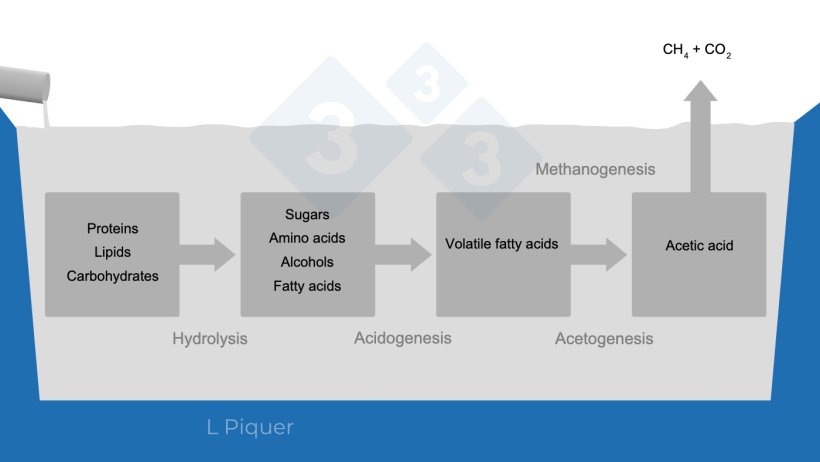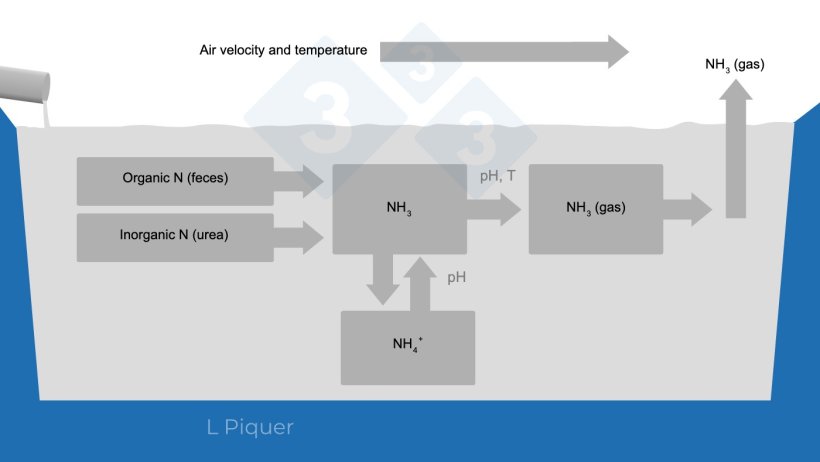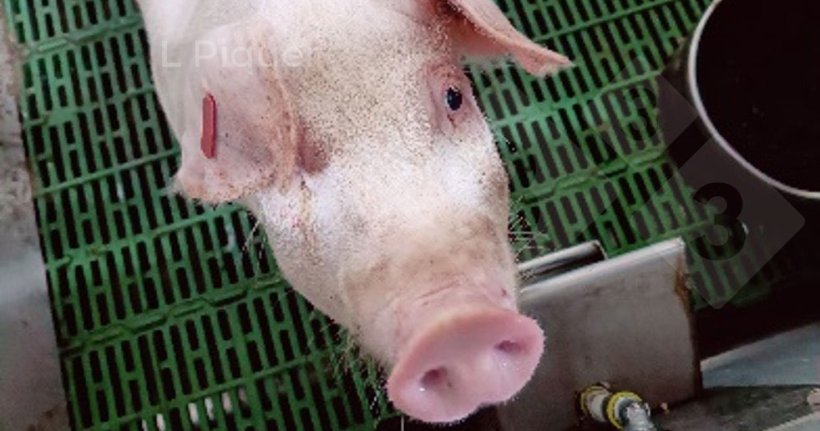Slurry storage and the resulting gas emissions are a growing problem in the swine industry and have been the subject of recent changes in the legal framework for pig farming. Feeding strategies are a way to mitigate this problem to some extent, as it has been shown that the type of nutrients provided in the diets and the way these nutrients are utilized by the animals can modify the composition of the slurry, and therefore can also modify the associated gas emissions.
The most significant gases generated from slurry are ammonia and methane. Ammonia emissions are generated from the conversion of excreted nitrogen to ammonia and methane emissions are generated from the degradation of organic matter in the slurry to carbon dioxide and methane (Figures 1 and 2).

Figure 1. Methane (CH4) formation cycle during slurry storage.


Figure 2. Ammonia (NH3) formation cycle during slurry storage.
Our research group has conducted several nutritional assessment studies with fibrous by-products that are widely available in the Mediterranean area, where their utilization by animals has been linked to effects on slurry and gas emissions.
This article presents the main findings of including brewers' spent grains (BSG) in diets on slurry composition and derived gas emissions. BSG, the main by-product generated by the brewing industry, is a potential protein source (24-27% CP) for livestock. However, for its use in pig feeding, the moisture content must be reduced to increase its shelf life, facilitate transport, and enable its inclusion in feedstuffs. In this study we worked with two types of BSG which was dehydrated sustainably, using energy from:
- A biomass-fired boiler (biomass BSG)
- Solar energy (solar BSG)
The experimental trials were conducted at CITA-IVIA experimental farms (Segorbe, Castellón, Spain). Five experimental diets were formulated: a basal diet and four diets where the energy fraction of the basal diet was replaced by 150 or 300 g/kg of each type of BSG, respectively, which were administered to thirty pigs weighing 59.9±3.66 kg (6 animals per diet).

Photo 1. Pig housed in metabolic pen
The experimental period consisted of a 14-day diet adaptation period and a 7-day total feces and urine collection period. Starting on day 9 of acclimation, the animals were housed in metabolism pens (Photo 1). The excreta collected during the first four days andthe BSGs and feed were analysed to calculate the nutritional value of the BSG, while the excreta collected during the last three days were used to obtain artificial slurries. The slurry was sampled for chemical composition analysis, and another sample was used for in vitro assays, which were performed to determine the potential ammonia (Photo 2) and methane emissions.

Photo 2. The slurry was analyzed for composition and in vitro tests were performed to determine potential ammonia and methane emissions.
Experimental diets with BSG showed higher fiber content, with lignin content being especially relevant, and higher protein and crude energy content than the basal diet (Table 1).
Table 1. Composition of experimental diets (g/kg DM)
| Basal diet | Biomass BSG | Solar BSG | |||
|---|---|---|---|---|---|
| 150 | 300 | 150 | 300 | ||
| Crude protein | 182 | 189 | 206 | 191 | 198 |
| NDF 1 | 86.8 | 147 | 211 | 155 | 220 |
| ADF2 | 27.9 | 50.7 | 72.9 | 52.8 | 76.8 |
| Lignin | 2.14 | 6.08 | 15.3 | 6.73 | 13.7 |
| Total dietary fiber | 118 | 200 | 255 | 194 | 252 |
| Crude energy (MJ) | 17.9 | 18.5 | 19.1 | 18.4 | 18.7 |
1NDF: Neutral detergent fiber with heat-stable amylase and no residual ashes
2ADF: Acid detergent fiber expressed without residual ash
In general, no differences were observed between the two types of BSG used in regards to slurry characteristics or emissions, and therefore the results for BSG are presented as a single treatment.
No significant differences were found in the amount of slurry excreted between treatments (Table 2). Slurry nitrogen concentration and pH, which are two of the main factors affecting ammonia emissions, were similar in all diets (Table 2). However, slurry ammonia emissions decreased with the inclusion of BSG (Table 2). Other studies in which fibrous by-products were used in feed indicate that increased fiber in diets can mitigate ammonia emissions from slurry due to changes in intestinal microorganism activity in the case of soluble fiber, and in the case of insoluble fiber due to a reduction in the digestibility of nutrients such as protein, which increase nitrogen excretion in feces, reducing nitrogen in urine and slowing down the ammonia formation pathway. This last hypothesis could be valid in the study with BSG since its fiber is mostly insoluble and its inclusion significantly reduced the urine : feces nitrogen ratio (Table 3).
Table 2. Excretion, artificial slurry composition, and emissions.
| Basal diet | 15% BSG |
30% BSG |
SEM1 | P-value2 | |
|---|---|---|---|---|---|
| Slurry excreted (kg/d) | 2.38 | 2.33 | 2.58 | 0.202 | 0.540 |
| Organic matter (g/kg DM) | 735c | 816b | 854a | 3.55 | <0.001 |
| Total ammoniacal nitrogen (g/L) | 4.60 | 4.84 | 4.98 | 0.450 | 0.799 |
| Total Kjeldahl nitrogen (g/L) | 9.45 | 10.6 | 10.3 | 0.570 | 0.277 |
| pH | 8.56 | 8.11 | 8.18 | 0.201 | 0.200 |
| g NH3 / kg slurry | 2.43a | 1.96b | 1.62c | 0.102 | <0.001 |
| ml CH4 / g organic matter | 223 | 232 | 248 | 8.74 | 0.089 |
1Standard error of the mean
2Significance between treatments
a,b,cDifferent letters in the same row indicate that they differ statistically (p<0.05).
Table 3. Effect of type and level of BSG inclusion on nitrogen balance (g/d).

| Basal diet |
15% BSG |
30% BSG |
SEM1 | P-value2 | |
|---|---|---|---|---|---|
| N ingested | 52.7b | 56.8b | 65.5a | 2.07 | <0.001 |
| N excreted in feces | 6.69c | 10.2b | 12.8a | 0.633 | <0.001 |
| N excreted in urine | 0.518 | 0.532 | 0.627 | 0.047 | 0.111 |
| N retained | 45.1b | 46.3b | 51.4a | 1.74 | 0.01 |
| N urine : N feces | 0.134a | 0.070b | 0.068b | 0.009 | <0.001 |
1Standard error of the mean
2Significance between treatments
a,b,c Different letters in the same row indicate that they differ statistically (p<0.05).
Although the inclusion of BSG in the feed resulted in an increase in the concentration of organic matter in the slurry, which could lead to higher methanogenic bacteria activity, no significant differences were found in the potential methane emissions. These results could be due to the higher amount of insoluble fiber present in the BSG diets compared to the basal diet, which, according to some studies, may slow down the activity of methanogenic bacteria and therefore slow down methane production to some extent.
In summary, including BSG that has been dried using environmentally friendly technologies in swine feed can have a positive impact on the sustainability of the feed in economic and environmental terms, due to its circular usage, its local availability, and its potential effect on reducing ammonia emissions from slurry. It is important to know the maximum level of inclusion in the feed that would allow this by-product to be used without negative consequences on production and animal health.



